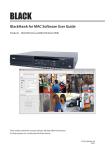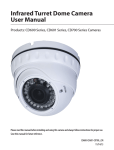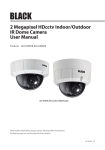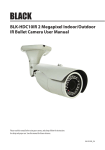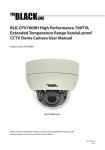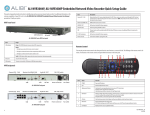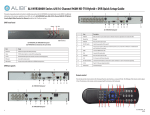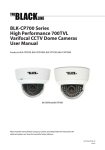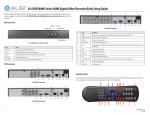Download ALIBI ALI-NVR5000P Series Setup guide
Transcript
ALI-NVR5000P Series Embedded Network Video Recorder Quick Setup Guide This quick setup guide provides instructions to initially setup and use the ALI-NVR5016P and ALI-NVR5032P network video recorders (NVRs). For additional information on the extensive capabilities of your NVR, refer to the ALI-NVR5000P Series Embedded Network Video Recorder User Manual provided electronically with your system. Name Function / Description 5/JKL/EDIT Enter numeral “5”; Enter letters “JKL”; Delete characters before cursor; Check the checkbox and select the ON/OFF switch; Start/stop record clipping in playback. 6/MNO/PLAY Enter numeral “6”; Enter letters “MNO”; Playback, for direct access to playback interface. 7/PQRS/REC Enter numeral “7”; Enter letters “PQRS”; Open the manual record interface. 8/TUV/PTZ Enter numeral “8”; Enter letters “TUV”; Access PTZ control interface. 9/WXYZ/ PREV Enter numeral “9”; Enter letters “WXYZ”; Multi-channel display in live view. 0/A Enter numeral “0”, or letter “A” Shift the input methods in the editing text field. (Upper and lowercase, alphabet, symbols or numeric input). Pess the button twice to switch the main and auxiliary output. NVR Front Panel Power and USB Ports (2) Status indicators Control Buttons Composite keys Jog Shuttle control Composite Keys (cont.) ALI-NVR5016P NVR front panel Name Status Indicators Status Indicators (cont.) Function / Description POWER Turns green when NVR is powered up. READY The indicator is green when the device is running normally. STATUS The light is green when the IR remote control is enabled; The light is red when the function of the composite keys (SHIFT) are used; The light is out when none of the above condition is met. The light is red when there is an alarm occurring. HDD Blinks red when HDD is reading/writing. POWER ON/OFF Power on/off switch. Tx/Rx Blinks green when network connection is functioning normally. USB Interfaces Universal Serial Bus (USB) ports for additional USB devices such as a mouse or Hard Disk Drive (HDD). DIRECTION In menu mode, the direction buttons are used to navigate between different fields and items and select setting parameters. In playback mode, the Up and Down buttons are used to speed up and slow down record playing, and the Left and Right buttons are used to move the recording 30s forwards or backwards. In the image setting interface, the up and down button can adjust the level bar of the image parameters. In live view mode, these buttons can be used to switch channels. ENTER The Enter button is used to confirm selection in menu mode; or used to check checkbox fields and ON/OFF switch. In playback mode, it can be used to play or pause the video. In single-frame play mode, pressing the Enter button will play the video by a single frame. In auto sequence view mode, the buttons can be used to pause or resume auto sequence. SHIFT Switch between the numeric or letter input and functions of the composite keys. (Input letter or numbers when the light is out; Realize functions when the light is red.) 1/MENU Enter numeral “1”; Access the main menu interface. 2/ABC/F1 Enter numeral “2”; Enter letters “ABC”; The F1 button when used in a list field will select all items in the list. Enter numeral “3”; 3/DEF/F2 Enter letters “DEF”; The F2 button is used to change the tab pages. In PTZ control mode, it zooms in the image. Composite Keys (cont.) 1 Move the active selection in a menu. It will move the selection up and down. In Live View mode, it can be used to cycle through different channels. In the Playback mode, it can be used to jump 30s forward/backward in video files. In PTZ control mode, it can control the movement of the PTZ camera. ALARM Control Buttons Composite Keys JOG SHUTTLE Control 4/GHI/ESC Enter numeral “4”; Enter letters “GHI”; Exit and back to the previous menu. NVR Backpanel eSata RS-232 Monitor Out (HDMI, VGA, CVBS) Camera Channels (POE) Audio OUT RS-485, Alarms IN / OUT USB LAN Ground Fan outlet Power connector ON / OFF switch Item Description eSATA Connects external SATA HDD, CD/DVD-RW. RS-232 Interface DB9 (male) connector for RS-232 devices VIDEO OUT (CVBS, VGA, HDMI) CVBS - BNC connector for video output VGA - DB15 connector for VGA compatible monitor. Supports 1920 × 1080p @ 60 Hz, 1600 × 1200 @ 60 Hz, 1280 × 1024 @ 60 Hz, 1280 × 720 @ 60 Hz/, 1024 × 768 @ 60 Hz HDMI - HDMI connector for an HDMI compatible monitor. Supports 1920 × 1080p @ 60 Hz, 1600 × 1200 @ 60 Hz, 1280 × 1024 @ 60 Hz, 1280 × 720 @ 60 Hz/, 1024 × 768 @ 60 Hz LINE IN BNC connector for audio input. ALI-NVR5016P_SQ 6/30/14 Remote Control Item Description RS-485, ALARMS IN/OUT See below. AC 100V ~ 240V AC 100 V ~ 240 V power supply. ON / OFF Switch Switch for powering the device on or off. GROUND Terminal for ground. Connect to earth ground before powering on the NVR. LAN Interface 10/100/1000BASE-T Ethernet network interface USB interface Universal Serial Bus (USB) ports for additional devices such as USB mouse and USB Hard Disk Drive (HDD). AUDIO OUT CVBS AUDIO OUT - BNC connector for audio output. This connector is synchronized with CVBS video output VGA AUDIO OUT - BNC connector for audio output. This connector is synchronized with VGA video output Internal Ethernet switch ports 16 ports for IP cameras. These ports provide Power over Ethernet (PoE) to the cameras. The enter key on the remote control or the front panel has the same function as a mouse left click. The IR Range of the remote control is 10 meters. The buttons on the remote control correspond with the buttons on the front panel. 17 RS-485, ALARMS IN/OUT 18 RS-485, Alarm IN / OUT terminations 2 13 16 15 12 14 10 8 6 4 11 9 7 5 1 3 2 Item Name Function 1 POWER Power on/off the device. 2 DEV Enables/Disables Remote Control. 3 Alphanumeric Buttons Switching to the corresponding channel in Live view or PTZ Control mode. Inputting numbers and characters in Edit mode. Switching between different channels in All-day Playback mode. 4 EDIT Button Editing text fields. When editing text fields, it will also function as a Backspace button to delete the character in front of the cursor. On checkbox fields, pressing the EDIT button will tick the checkbox. In Playback mode, it can be used to generate video clips for backup. Item Description 5 A Button Switching between input methods (upper and lowercase alphabet, symbols and numeric input). SW ON RS-485 termination switch: Up position is not terminated. Down position is terminated with 120 Ω resister. 6 REC Button Entering the Manual Record settings menu. In PTZ control settings, press the REC button and then you can call a PTZ preset by pressing Numeric button. RS-485 (T+, T-, R+. R-) T+ and T- pins connect to R+ and R- pins of PTZ receiver respectively. 7 PLAY Button Playback, for direct access to playback interface. INFO Button Reserved. KB Controller port: D+, D- pin connects to Ta, Tb pin of controller. For cascading devices, the first NVR’s D+, D- pin should be connected with the D+, D- pin of the next NVR 8 9 VOIP button Selecting all items on the list; In live view or playback mode, it can be used to switch between main and spot video output ALARM IN (1 through 16) Alarm inputs 1 - 16. Alarm input is tied to ground through the alarm sensor. 10 MENU button ALARM OUT (1-G through 4-G) Press the button will help you return to the Main menu (after successful login). Press and hold the button for 5 seconds to turn off audible key beep. Alarm outputs 1 - 4 with ground terminations. 11 PREV button Switch between single screen and multi-screen mode. 12 DIRECTION/ENTER buttons Navigating between different fields and items in menus. In Playback mode, the UP and DOWN button are used to speed up and slow down recorded video. The LEFT and RIGHT buttons select the next and previous day of recordings. In LIVE view mode, these buttons can be used to cycle through channels. 13 PTZ button Enter the PTZ Control mode. 14 ESC button Return to the previous menu. Press for Arming/disarming the device in Live View mode. 15 RESERVED Reserved for future usage. 16 F1 button Selecting all items on the list when used in a list field. In PTZ Control mode, it will turn on/off PTZ light. 17 PTZ Control buttons Buttons to adjust the iris, focus and zoom of a PTZ camera. 18 F2 button Cycle through tab pages. www.Observint.com © 2014 Observint Technologies, Inc. All rights reserved. Mouse Control A standard 3-button (left/right/scroll-wheel) USB mouse can also be used with this NVR. To use a USB mouse: 1. Plug USB mouse into the either the front panel or backpanel USB connector of the NVR. 2. The mouse will be automatically detected. If the mouse is not detected, the mouse may not be compatible with the NVR. Please refer to the recommended device list from your provider. Switch to symbols Backspace Switch to alphanumeric Enter The operation of the mouse: Action Effect Right click Live view: Show menu. Menu: Exit current menu to upper level menu. Soft keyboard - numeric Single click: Live view: Select channel and show the quick set menu. Menu: Select and enter. Double click: Live view: Switch between single-screen and multi-screen. Left click Click and drag: PTZ control: pan, tilt and zoom. Tamper-proof, privacy mask and motion detection: Select target area. Digital zoom-in: Drag and select target area. Live view: Drag channel/time bar Scroll wheel Switch to alphanumeric Backspace Switch to numeric Scroll up: Live view: Previous screen. Menu: Previous item. Enter Soft keyboard - symbols Scroll down: Live view: Next screen. Menu: Next item. Step 1. Connecting alarm devices to the NVR Soft keyboard Wiring alarm inputs to the NVR One of two on-screen keyboards appears when you click in a field that accepts a entry, such as a password or name or a numerical value. A third keyboard which includes symbols can also be opened while in the numeric keyboard. The alphanumeric keyboard is shown in the following picture. Some control keys toggle their function when they are clicked. A numerical keyboard, shown beneath, appears for numerical entries such as an IP address. Uppercase / Lowercase Backspace Switch to numeric Enter Soft keyboard - alphanumeric 3 www.Observint.com You can wire up to 16 alarm inputs to the NVR. Alarm input wiring connects to the RS-485, Alarm IN/OUT connector blocks on the back of the NVR. – + Sensor Typical ALARM IN wiring © 2014 Observint Technologies. All rights reserved. Wiring alarm outputs to the NVR 1.1 Install a monitor, mouse, power The NVR provides 4 alarm output terminations. These terminations for each output are on the ALARM OUT connector block on the back of the NVR , and are labeled 1 - G, 2 - G, 3 - G, 4 - G (G = ground termination). For the following steps, refer to the back panel photo above for the location of connectors. There are 4 jumpers (JP1, JP2, JP3, and JP4) inside the chassis on the alarm termination PC board, associated with ALARM OUT pins 1, 2, 3 and 4 respectively. Initially, these jumpers are in place. If connecting an alarm output to a DC loaded alarm out circuit, the jumper must be in place. If connecting the alarm output to an AC loaded alarm, the corresponding jumper must be removed. Example: If you connect an AC load to the alarm output 3 of the NVR, then you must remove the JP 3. To remove a jumper for AC load alarm circuits: 1. Install and setup your monitor in accordance with the instructions provided with the monitor. Do not power it on at this time. 2. Cable the HDMI or VGA connector to your monitor’s VGA or HDMI input. The HDMI interface provides the best performance. 3. Plug the mouse into the USB connector on the front or back of the NVR. 4. If you plan to access your NVR remotely, or configure your NVR to transmit alerts, email, etc. to external servers, plug a drop cable from your local area network (LAN) into the RJ45 LAN connector on the back of the NVR. 5. Connect the power cord to the power connector on the back panel of the NVR, and then into a UPS (preferred) or surge protector. 1. Disconnect all cabling from the NVR. 2. Remove the NVR top cover: Remove the two cover screws on the back of the chassis, the slide the cover toward the back until it is free. 3. Locate the jumper associated with the alarm output you are using for an AC load alarm, then remove it. Save the jumper for use later, if needed. Step 2. Connecting it together – initial system setup Reinstall the NVR top cover. 1. 4. NOTE Do not power on the NVR at this time. Plug the LAN cables from the cameras into the POE RJ45 connectors on the back of the NVR. If other cameras to be monitored by the NVR will network to it through the LAN, plug their Ethernet cables into a switch (router) on the LAN and power on those cameras. (Power to other cameras on the LAN may be provided through a PoE switch if the camera is PoE capable, or through a separate cable and power adapter). DC load alarm output circuits DC loads must operate within the limitation of 12V/1A. To connect to a DC alarm output, use the following diagram: 2. Power on the NVR using the power on / off (I / O) switch on the back panel. 3. Power on the monitor. NOTE Some monitors have multiple inputs such including VGA ,HDMI, BNC, etc. If you are using this kind of monitor, configure your monitor to display the input connected to your NVR (HDMI or VGA). Step 3. Using the Wizard for basic configuration setup AC load alarm output circuits To connect an AC load to an alarm output, a jumper, associated with the output on the alarm termination PC board, (within the chassis), must be removed. These jumpers shunt pin pairs J1, J2, J3, and J4 for alarm outputs 1, 2, 3, 4 respectively. Use an external relay for safety. 4 www.Observint.com 1. Power on the NVR. Normally, an Alibi logo splash screen appears within 2 minutes. A secondary flash screen will appear showing the status of the HDDs installed in the NVR. © 2014 Observint Technologies. All rights reserved. Observint strongly recommends that you change the default admin user password to improve the security of your surveillance system. To change the admin password, check the New Admin Password box, then enter the new password in the New Password and Confirm fields. After the Alibi splash screen appears (see above), the NVR will check the status of HDDs installed within the chassis, and show the show icons on the screen indicating their status. A green check mark on the icon indicates that the associated HDD is operating normally. If you installed new (or uninitialized) HDDs in the chassis before running the Wizard, those HDDs must be initialized before use. HDD initialization can be performed within the wizard and within the firmware menu system. Following the splash screen, a monitor resolution screen may appear. Open the drop down list and select the monitor resolution you prefer, then click OK. 2. The Setup Wizard can assist you in making important configuration settings in DVR. Click Next button on the Wizard window to open the Login window. NOTE The configuration settings presented in the setup Wizard can also be made and changed using the Menu system. See Chapters 5 - 7 for more information. 4. 3. 5 Click the Next button to open the date and time settings window. Enter the admin password in the appropriate field. To do that, click inside the Admin Password field to open the virtual keyboard. Click the appropriate keys (icons) to enter the password, then click the Enter icon. The default admin password is 1111. www.Observint.com © 2014 Observint Technologies. All rights reserved. 5. In the date and time setup window, click the field you want to change, then use the drop-down list or setup aid to select the appropriate values. Click Next to confirm your settings or Cancel to discard them and open the network setup Wizard window. 6. In the Network setup Wizard window, click the field value you want to change, then use the pop-up aid to enter a new value. By default, the DVR uses DHCP (Dynamic Host Configuration Processor) to acquire compatible (dynamic, changeable) network settings from a network DHCP server. 8. In the next window, the Wizard will search the LAN to find compatible cameras to add to the system. With the ALI-NVR5016P, you can monitor up to 16 IP cameras total (the sum of those attached to ports in the integrated 16-port Ethernet switch plus those added from the LAN the NVR is attached to). With the ALI-NVR5032P, you can monitor up to 32 IP cameras total (up to 16 attached to the 16-port Ethernet switch on the back of the NVR plus up to 16 added from the LAN the NVR is attached to). Generally, it is preferable to setup the DVR with a fixed network settings, if possible, to assure the DVR has an unchanging IP address for remote login. To enable fixed network settings, un-check the Enable DHCP box, then edit the appropriate fields to change the settings. Consult with your network administrator to determine the best network settings for your DVR. When finished, click Next. Check the select boxes for the cameras you want to add, then click the Add button (see above). 9. 7. 6 Click Next after you configured the network parameters. The HDD management Wizard window will open. If a new DVR is shipped with a pre-configured HDD, nothing needs to be done in this window. If you installed an HDD or replaced the HDD, select (check the box for) the HDD, then click Init to setup the disk for the DVR. NOTE: Init will erase all data from the disk. When the initialization is complete, click Next to continue. www.Observint.com On the next screen, you can configure all cameras to begin recording video either continuously, when motion is detected, or not record (select no options). The recording mode of individual cameras can be configured using the menus in the firmware. See the ALI-NVR5000P Series Embedded Network Video Recorder User Manual for more information. © 2014 Observint Technologies. All rights reserved. Click the star for Continuous or Motion Detection, click Yes in the Attention pop-up window, and then click OK to save the settings. The Wizard will close and the NVR will present the Live View display. See the ALI-NVR5000P Series Embedded Network Video Recorder User Manual for more information. Live View display after camera adjustments Step 4. Access the Menu system After the initial setup of your DVR using the Wizard, the Menus interface enables you to refine your configuration settings and expand the functionality of the system. To use most menus, the user must log into the DVR system, either locally or remotely, with administrative privileges. To open the Menu system from the Live View screen, right click anywhere in the screen, then select Menu. Live View display 10. While viewing video from each cameras in the Live View display, adjust the direction of each camera to aim it at its surveillance target. Follow the manufacturer’s recommended procedures for aiming the cameras. 7 www.Observint.com If ID Authentication is not disabled (see the Menu | Configuration | General settings), a login window will open. In the Login window, select a User Name with administrative privileges, enter its password, then click OK. NOTE: A window of Menu icons will open. The default user “admin” has the default password of “1111”. © 2014 Observint Technologies. All rights reserved. Model ALI-NVR5016P Operating System Security Password Protection Protocols IPv4, TCP/IP, UDP, HTTP, UPnP, RTSP/RTP/RTCP, SMTP, FTP, DHCP, NTP, DNS, ONVIF, HTTP multipart Power Requirements Power Consumption Weight Model ALI-NVR5032P 16 14 °F ~ 131 °F (-10 °C ~ +55 °C) Aluminum Approvals CE, FCC, RoHS Remote Client System Requirements 100 Mbps max Remote Viewing Output Capacity 240 Mbps max 160 Mbps max Continuous, Schedule, Alarm, Motion Detection Continuous, Schedule, Alarm, Motion Detection Supported Playback Resolution Synchronous Playback Video Output Video Output Formats Software Requirements WebCompnent Installation Mobile Client OS Platform iOS, Android (Alibi Witness) 5MP / 3MP / 1080p / UXGA / 720p / VGA / 4CIF / DCIF / 2CIF / CIF / QCIF 5MP / 3MP / 1080p / UXGA / 720p / VGA / 4CIF / DCIF / 2CIF / CIF / QCIF 16-ch, 720P / 8-ch, 1080P / 1-ch, 5 MP 16-ch, 720P / 8-ch, 1080P / 1-ch, 5 MP VGA, HDMI, CVBS 1 channel (HDMI / VGA), resolution: 1920×1080P / 60 Hz,1600×1200 / 60 Hz, 1280×1024 / 60 Hz, 1280×720 / 60 Hz, 1024×768 / 60 Hz, 1 channel (CVBS), resolution: 704×480 1-ch, BNC (2.0 Vp-p, 1 kΩ) Audio Output 2-ch, BNC (Linear, 600 Ω) MP4 1x Gigabit RJ-45 self-adaptive Ethernet interface, 16 independent 10 /100 Mbps PoE Ethernet interfaces (200 W max output) Ethernet USB 3x USB 2.0 Hard Drive Interface 4x SATA Hard Drive Capacity 4x HDDs max., up to 4TB capacity per HDD eSATA 1x eSATA interface Serial Interface 8 Microsoft Internet Explorer 8.0, 9.0, 10, and 11 (32-bit version), Mozilla Firefox 13 and higher and 3.6, Safari 5 and higher, Google Chrome 200 Mbps max Audio Input Export Formats Microsoft Windows 2000, 2003, XP, Vista, 7, 8 (32-bit and 64-bit version) / Linux 2.6+ / Apple MacOS X 10.5 (Intel x86 only), 10.6 and 10.7 H.264 Recording Performance Supported IP Camera Resolution Black Material 32 Compression Format Recording Type 8.8 lbs. (4 Kg) without HDD(s) Operating Temperature Web Browser ALI-NVR5016P Number of Channels Supported ≤ 45 W 17.5" × 15.3" × 2.8" (445 mm × 390 mm ×70 mm) Operating System Specifications 100 ~ 240 Vac, 6.3 A, 50 ~ 60 Hz ≤ 40 W Dimensions (W × D × H) Color / Material For additional information about using your system, refer to the ALI-NVR5000P Series Embedded Network Video Recorder User Manual provided electronically with your system. ALI-NVR5032P Embedded Linux 1x RS-232; 1x RS-485 Alarm Input 16 Alarm Output 4 www.Observint.com © 2014 Observint Technologies. All rights reserved.









